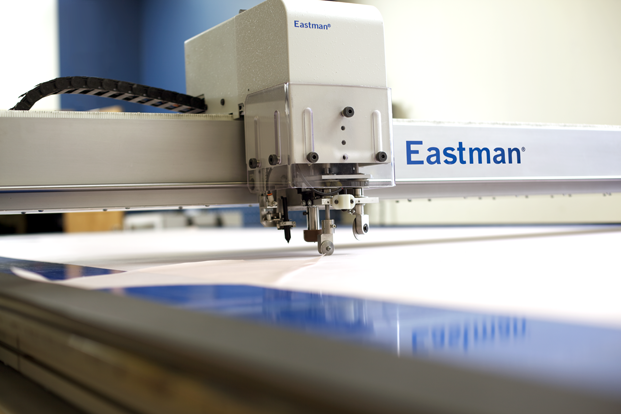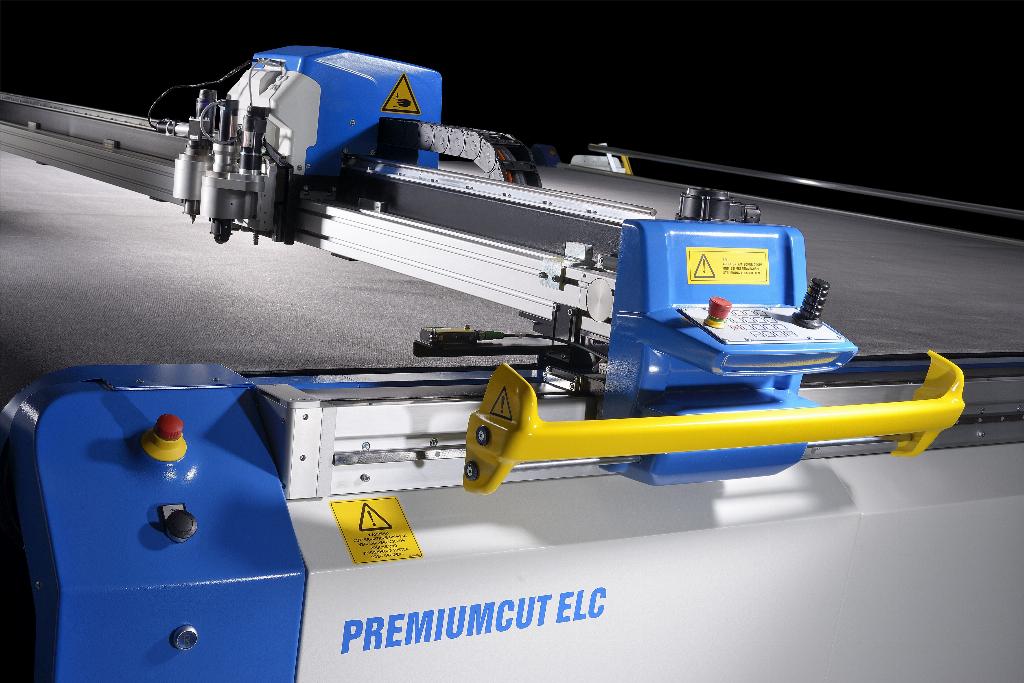Making it big in composites

Composite materials have become the mainstay of component manufacture in a variety of industries. However, the handling and processing of these materials can be a real challenge, as Ian Vallely discovers.
The benefits associated with composites are seemingly endless – they’re lightweight, strong and durable; resist corrosion; are fire retardant; provide remarkable design flexibility; are non-magnetic and non-conductive; can form complex shapes; have outstanding damping properties; offer dimensional stability… the list goes on.
All these advantages make composites a must-have material in a range of manufacturing sectors, but there’s a problem: The technology employed to handle and process composites – including robots and flatbed cutting machines – must overcome a series of challenges in order to work effectively.
Mike Wilson, sales and marketing manager – general industry UK & Ireland at ABB Robotics (www.abb.co.uk/robotics), identifies one: “The biggest challenge would be to deal with many different shapes cut from one sheet using flexible grippers, but also to deal with separating these items in case the cut is not 100%.”
He adds that, although composite materials – typically in sheets – weigh very little, they tend to be large and ‘floppy’. In order, quite literally, to handle this, the grippers can be sizeable and heavy: “The robots are therefore also relatively large. They can be 6-axis machines if orientation of the part is required or, more likely, if it is a simple pick and place, then a four-axis machine similar to a palletising application can be used.”
However, Wilson insists, many composite production applications remain manual because of the handling challenges, which include materials being tacky, a wide range of part sizes and the need to pick varying shapes from cut sheets.

Pick up the pace
For Elizabeth McGruder, marketing manager at Eastman Machine Company (www.eastmancuts.com), integrating a robot to pick-and-place can increase production rates and automate the task of handling large, small or hard-to-handle pieces.
“A robot introduces an automated method for picking parts up and placing them in another location,” She states. “There is consistent speed and control over routine tasks and, generally, the robots can be programmed and built for multiple material applications. Human supervision is generally still necessary so that modifications to the workflow can be made on demand.”
However, she adds, the costs associated with selecting and implementing the correct robotic system can be high: “With the variety of material compositions, piece dimensions and volumes to be cut, selecting the appropriate robot design to meet the changing demands of your operations can be challenging. Working with suppliers demonstrating proven, industrial production success who are able to recommend the correct configurations could streamline the buying process.”
Composite manufacturing typically involves the use of prepreg. However, the prepreg’s resin can make it tacky, which can present problems for cutting equipment. For example, McGruder says, tacky prepreg could implicate the cutting knives and the cutting surface, resulting in poor results. She says this can be overcome by working in a climate-controlled environment; maintaining a standard process for removing material from the freezer before cutting and using recommended machine settings for blade pressure to minimise contact between the prepreg and cutting surface.
“Depending on the volumes to be cut, the application and the customer’s budget, the appropriate solution will be configured,” she adds. “These custom-engineered system solutions can cut a variety of prepreg and dry aramid, glass and carbon fibres in uni-, bi-, or multi-directional orientation as well as foams and other non-woven core materials.”
Eastman’s smooth-cast urethane belt cutting surface, perforated with millions of holes in a patented configuration, is designed to provide the appropriate amount of material hold-down while cutting and easy removal in the piece-removal zone area of the cutter “and material tackiness is generally not an issue”.
“Initial testing exercises can help confirm the temperature where best cutting results occur,” notes McGruder. “An optional chilling device integrated into the tool head design can blow a continuous stream of cool air onto the blade to minimise tackiness or resin build-up, but is not necessary in most cases.”

Cutting remarks
For Martin Sofranko, account manager in sales at Assyst Bullmer (www.assystbullmer.co.uk), depending on the type of prepreg specified, you can cut it with a drag knife or an electric oscillating knife. Both use strong carbide tungsten blades, which deliver high cutting quality.
He adds that problems with tackiness can be mitigated, at least in part, by reducing the cutting speeds (which means there is less friction on the material from the cutting blade) or using a drag knife tool. “We have also explored cooling of the blade; this, however, does not always deliver reliable results.”
Nonetheless, Sofranko insists: “During some of the past projects, we even managed to cut multi-plies of the material. Material was 900g/per m2 glass fibre.”
Handling efficiency is also reduced if tacky prepreg sticks to the end effectors on robot arms. Scott Sevcik is director of aerospace and defence business development at Stratasys (www.stratasys.com), a specialist in 3D printing. His company does not deposit traditional composite feedstocks, which, he says, overcomes this problem.
A demonstration by Stratasys at the recent IMTS exhibition in Illinois, used two different methods of depositing carbon fibre reinforced thermoplastic.
“In both cases, we pre-compound the composite material,” Sevcik explains. “We then extrude a filament of highly reinforced thermoplastic that we deposit through a traditional fused deposition modelling extruder, or we create a micro-pellet feedstock which we extrude at the point of deposition through a miniaturised screw extruder. In both cases, we’re flowing the material from the end effector in a highly controlled fashion and do not need to contend with [composite sticking to the end effector].
“For the first time, we can combine the design freedom of additive manufacturing with the strength and light weight of composite materials to create bionic structures that have strength to weight ratios never before achievable.”
However, one criticism of manufacturing large and complex 3D components from composites is that it can be time consuming and costly.
The tide is turning
The ATTOM project (affordable tidal turbines via optimised manufacture) is one of 17 integrated projects being delivered by the Composites Innovation Cluster (CiC) under the Advanced Manufacturing Supply Chain Initiative (AMSCI).

Led by Cytec Solvay group, the ATTOM project has been investigating the prospects for automation or improved materials handling methods to cut costs. The project will ultimately contribute to developing a UK-based supply chain that can produce better designed tidal turbine blades with a labour saving of up to a 30% by employing automated handling and storage techniques.
Cytec Solvay group, tidal turbine blade manufacturer AEL Airborne, project partners and equipment suppliers Assyst Bullmer and Güdel UK have implemented and commissioned an integrated material preparation, handling and storage cell within Cytec Solvay group’s application centre in Heanor.
The 10m long Güdel Cartesian overhead gantry has demonstrated repeatability and accuracy, dynamically picking ply geometries from the XY cutting system. The end-effector, developed specifically for this application, and mounted directly to the Güdel gantry, has proven reliable in the collection, transfer and deposition of different ply geometry, some up to 7m in length, within a fully-automated storage system. The end effector can roll the 7m long ply pieces and flat-pick the smaller ply geometries.
The next stage in the project involves using nesting algorithms to ensure plies are cut efficiently to maximise the use of material, and stored by the Güdel gantry robot in the ply deposition order. This will reduce or even eliminate the 23 hours of manual handling/sorting of plies on average currently required. The project has achieved remarkable improvements and the problems solved are generating interest from other areas of composite production.
Meanwhile, Assyst Bullmer has employed this sort of innovative thinking to its own processes and now offers solutions which originated in the graphics industry. These allow the user to scan the material, read in the orders via QR code directly from the cutting head of the machine or via barcode scanner connected to the cutting software.
And, Sofranko says his company has overcome the biggest challenge with robots in automating composite manufacture – the size of the parts and nesting versus pick up sequences: “In the first project we had, we had to work with a set sequence of cut parts.
“With the latest development, we can cut live nests regardless of the shape of the part. This is due to the new end effector tool, with vacuum zones switching on and off in order to copy the shape of the parts. We can also pick up long parts – up to 10m.”
So what of the future? As the use of composites moves more and more into mainstream production – and particularly as volumes increase – pressure will grow to automate further, something that is bound to drive the development of a new range of innovative, cutting-edge solutions (literally).
Making the cut
A static table cutting system is, says Eastman Machine Company’s Elizabeth McGruder, ideal for rapid prototyping, R&D work and full volume production. She says many prepreg cutting facilities employ this type of machine to ensure consistent repeatability over long pieces or have the ability to cut very intricate markers that have little room for error.“Eastman’s static table system is capable of cutting, marking and punching virtually any flexible material at speeds of up to 1,500mm/s,” she states. “Precision racks and rails on the machine in the X and Y axis and the ability to adjust motor settings help achieve position accuracy to within a tolerance of 0.20mm and repeatability within 0.38mm (depending on material and machine configuration).
“Optional table mapping software achieves high-resolution calibration over the entire cutting surface to ensure tolerances remain controlled.”
The machines can be configured for small workspaces or as long as a helicopter or wind turbine blade. Active cutting zones can be as narrow as 1,340mm to more than 5m and lengths from 1,220mm to 30m and greater.








